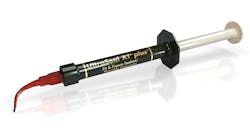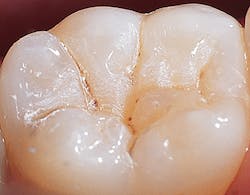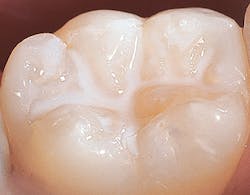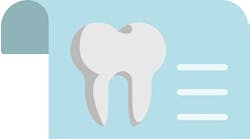In a dental world full of new and emerging technology, let us not forget the basics. In my pediatric dental practice, we place great emphasis on prevention. That includes diet and oral hygiene instruction with patients and caregivers, fluoride application, and, specifically, sealants. Sealants are a protective coating for the grooves of teeth where toothbrush bristles and floss can’t reach, particularly the back teeth such as premolars and molars. Think of sealants as the Captain America shields against tooth decay. They are indicated in the primary and permanent dentition with deep pits and fissures, susceptible bacteria, plaque retention, and acid attack, in addition to patients with a history of dental caries or who are at a higher risk for dental caries in the future.
According to the most recent Cochrane Review on sealants completed in 2017, in children ages five to 10, resin-based sealants reduced caries at 24 months between 11% and 51% compared to those having no sealants.1 Another Cochrane Review also found that dental sealants reduce more tooth decay in the grooves of children’s molars than fluoride varnish application does, although evidence was low.2 Sealants can also minimize progression of noncavitated occlusal incipient lesions.3-4
There are various types of sealant materials—from resin-based to glass ionomer, self-cure to light-cured, filled versus unfilled, fluoride-releasing, tooth-colored to color-changing, and opaque to translucent. Resin-based sealants are the ideal choice, but glass ionomer cements are an option when moisture control is an issue.4
The keys to proper sealant placement and retention are good isolation and technique. I prefer to use Isolite or Isovac (Zyris) dental isolation systems when placing sealants, because they have a built-in bite block, control the patient’s cheeks and tongue while protecting the airway, come in many sizes, and have a light for better illumination of the oral cavity. I find that it is well accepted among my patients, especially with good training and tell, show, do with the patient prior to placement. The edges of the Isolite can be trimmed for patient comfort if necessary.
For patients with a severe gag reflex who cannot tolerate an isolation system such as these, I’ll use a bite prop or Molt mouth prop, dry angles, cotton rolls (attached to floss for protection against aspiration), and four-handed dentistry with adequate suction.
My protocol for placing pit-and-fissure sealants
- Clean the tooth’s pits and fissures with a pumice-water slurry and a polishing brush or rubber cup attached to a handpiece.
- Isolate to prevent moisture contamination.
- Apply etchant (phosphoric acid solution) for 20 seconds, and then rinse with water and dry with suction and air.
- Apply a thin layer of bonding agent,5 and then air thin and light cure for 10 seconds (or as instructed by your bonding agent manufacturer’s recommendations).
- Apply a thin layer of sealant material in all pits and fissures of the tooth, and light cure for 20 seconds (or as instructed by your sealant material manufacturer’s recommendations).
- Check and adjust occlusion as necessary.
- Review and provide post-op diet and care instructions.
Sealants are noninvasive, easy to place, cost-effective, and critical players in the fight against dental caries! Don’t underestimate the power of sealants in your practice. Incorporate them into your overall prevention plan for your patients. The CDT code for sealants is D1351. You can find great resources and infographics for your patients from the American Dental Association (ada.org) and the Centers for Disease Control and Prevention (cdc.gov).
References
1. Ramamurthy P, Rath A, Sidhu P, et al. Sealants for preventing dental caries in primary teeth. Cochrane Database Syst Rev. 2018,3(CD012981). doi:10.1002/14651858.CD012981
2. Hiiri A, Ahovuo-Saloranta A, Nordblad A, Mäkelä M. Pit and fissure sealants versus fluoride varnishes for preventing dental decay in children and adolescents. Cochrane Database Syst Rev. 2010;(3):CD003067. doi:10.1002/14651858.CD003067.pub3
3. Splieth C, Förster M, Meyer G. Additional caries protection by sealing permanent first molars compared to fluoride varnish applications in children with low caries prevalence: 2-year results. Eur J Paediatr Dent. 2001;2(3):133-138.
4. Wright JT, Crall JJ, Fontana M, et al. Evidence-based clinical practice guideline for the use of pit-and-fissure sealants: A report of the American Dental Association and the American Academy of Pediatric Dentistry. J Am Dent Assoc. 2016;147(8):672-682.e12. doi:10.1016/j.adaj.2016.06.001
5. Llodra JC, Bravo M, Delgado-Rodriguez M, Baca P, Galvez R. Factors influencing the effectiveness of sealants—a meta-analysis. Community Dent Oral Epidemiol. 1993;21(5):261-268. doi:10.1111/j.1600-0528.1993.tb00771.x
Note
i. Sasa I, Donly KJ. Sealants: a review of the materials and utilization. J Calif Dent Assoc. 2010;38(10):730-734.









